The Strong Female Lead: Modern Cinema’s Take on Women’s Strength
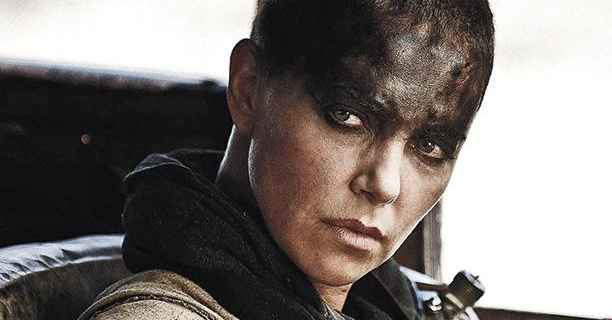
Any preconceived notions about feminism aside, there has been a rise of vigorously strong and talented women in movies lately. This trend didn’t spike overnight, however, and the characteristics we see in these strong female leads have morphed slowly over time, from the outspoken woman who refuses to get married, to the stoic warrior wielding an assault rifle. Without question, action films from the past few years have emphasized the beauty that comes with brawn, but are these action heroines still fighting for respect and authenticity?
It seems that now more than ever is the perfect time to diagram the characteristics of the Strong Female Lead; her evolution plays out significantly in the current marketing and overall perception of action heroines. Wonder Woman (2017)―now the highest-grossing film of all time for a female director―has been getting a lot of hype for bringing a new kind of superhero origin story to the DCEU. Diana’s character development, presents a blend of what Hollywood has historically portrayed as “masculine” and “feminine” qualities. Her aggression is directed at the enemy, though she is “nonetheless feminine,” expressing giddy delight for “babies, ice cream, and snowflakes” (Lowry). While this hybrid approach to her character is pointed to frequently, some argue that Wonder Woman’s creator, psychologist William Moulton Marston, would not have been pleased with her outward stereotypical femininity. He explained that the character was designed to be “psychological propaganda for the new type of woman who should, I believe, rule the world,” a radical vision of feminism; he was of the opinion that “not even girls want to be girls so long as our feminine archetype lacks force, strength and power ” (Foreman). Ticket sales and positive reviews, if relied upon as objective sources, both support and refute Marston’s view. Though powerful, the Strong Female Lead can be an advocate for peace, proving the “feminine” quality of empathy a heroic trait.
Battle of the stereotypes
Many action heroines before Gadot’s Wonder Woman were criticized for being too stereotypically masculine—emotionless, power-hungry, or stripped of any delicacy or flexibility. This criticism led a fair amount of critics to conclude that Hollywood is overtly pushing a feminist agenda, that action heroines are against “human nature” and are doing women a disservice by setting “unattainable goals” (Kirchoff). But the logic of these arguments are not consistent; it is condescending, yet nevertheless true, to argue that it is not in a man’s nature to throw a bus or shoot lasers from his eyes.
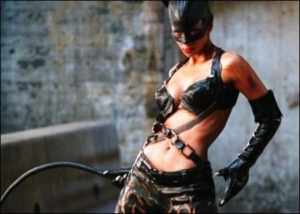
Characters like the fearlessly aggressive Furiosa of Mad Max: Fury Road (2015) and coolly competent Rey of Star Wars: The Force Awakens (2015) carry themselves quite differently than the feverishly emotional Katniss Everdeen of The Hunger Games series (2012‒2015) the hypersexualized fighters like Patience in Catwoman (2004) and Lara Croft in Lara Croft: Tomb Raider (2001). Each woman is the main character of an action film; all strong, all competent, but they appeal to audiences for different reasons. Katniss’s action-oriented mission to overthrow a sadistic government loses its vigor when the script allows her quest to be overpowered by a messy love triangle. Catwoman, dressed in leather, starts off as the stereotype-fulfilling shoplifter and gradually becomes a hallmark for BDSM fanatics, choking her enemies with whips.
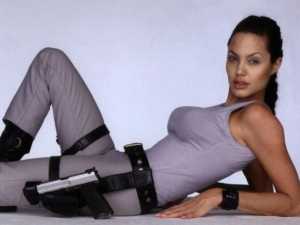
Lara, a shallowly written variation of Indiana Jones, might not have drawn much interest if it weren’t for her plump lips, tight clothes, and suggestive poses. Despite her strengths as a skilled fighter and archeologist, these are not the traits that receive the spotlight in both the film’s cinematography and its marketing. Hypersexualization has persisted into the 2010’s with characters like Scarlett Johannson’s Black Widow. Furiosa and Rey, on the other hand, do not purposely appeal to sexuality, aren’t forced through any romantic subplots (despite the available opportunities in the script), and are fixated on their goals. These calculated, non-sexual depictions of action heroines are deemed masculine for one of two reasons: either their credibility as strong characters is viewed differently than strong males despite being fictional, or they break an uncomfortable mold.
It is easy to point to the normalization of stoic and powerful action heroes like James Bond, Indiana Jones, and Batman. Each of these classic heroes lack a certain level of emotional depth and vulnerability that heroines are, with painful irony, often criticized for lacking. Fandom and their iconic status have allowed us to overlook the fact that these heroes are nothing like ordinary men. The categorization of female masculinity is then broken down further, not just by how the character handles a conflict, but on the conflicts themselves. Sociological Cinema adds to the conversation on gendered conflicts:
It is usually an emotional obstacle the female character is challenged to overcome, unlike the critical thinking problems male characters are shown solving . . . the lack of neutral symbolism perpetuates the idea that women are not faced with, and cannot then comprehend, anything other than emotional stressors (Kraljevich)
Defining femininity by empathy and masculinity by a lack of it becomes increasingly problematic, as the very concept of emotion versus reason becomes gendered to the point of creating distinct behavioral patterns for men and women on the screen. Conflicts, plot lines, characters arcs: they are dictated by perceptions of the character’s abilities to problem solve. The recent emergence of the Strong Female Lead, one with complete control over her emotions in addition to her strength, agility and competence, is scraping against the grain of classic storytelling methods that place women at the center of relational tornadoes.
In 2009, the Strong Female character was rebranded by the vengeful, Nazi-killing Shoshanna Dreyfus in Quentin Tarantino’s Inglourious Basterds. Shoshanna teases out the emotional weight of war and death without her cunning being swept away by those emotions. While the audience catches glimpses of her anxiety, a tasteful and realistic choice by Tarantino, Shoshanna masterminds a brutal attack on a theater full of Nazis. Her willpower, complexity, and verisimilitude do not call for fist fights to demonstrate her strength. This characteristic, one that matches several other women written by Tarantino, is written with thoughtful consideration of how women are perceived in reality and translated onto screen. Tarantino is also known for not sexualizing the women in his films while still inserting sexual themes. And without sexualization or stereotypes, he manages to present women with depth, who are hinges on the central tension.
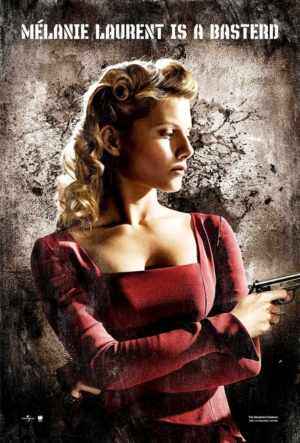
The marketing for Inglourious Basterds, however, cast Shoshanna in traditionally “masculine” terms. Referring to actress as a “Basterd” while showing a traditional action poster pose draws attention because it is pairing two conflicting images, one masculine, one feminine. The tagline matches Shoshanna’s role in the film, it is brilliantly playing on the expectations of audiences. Intrigue is generated by the dolled, feminine-looking Melanie Laurent who, knowing Tarantino’s history with strong female leads, will shed some blood.
Considering the long line of Strong Female Leads, their different strengths and motivations, and their ability to draw audiences, it is difficult to pin down a legitimate reason for critics, professional or casual, to say that Hollywood is making strong women masculine. As for the debate if these female characters are authentic representations of women, it is impossible to generalize an answer due to the nature of fiction. When female characters are criticized for having superhuman strength, the defense can simply point to the countless male characters who do as well. Perhaps the only step necessary in this argument is to ask critics why they view female characters as masculine for not emphasizing their figure, their emotions, or their romantic interests.
The swann effect
With the diversity of Strong Female Leads we have to look at the differences between plot-driven and character-driven narratives, which will affect how these women are portrayed and what function they have in the story. The stronger a female lead gets, the more central she becomes to the narrative. This is especially true of movies like Mad Max, Star Wars: The Force Awakens, The Hunger Games, and even older classics like Alien (1979). Women like Black Widow in Avengers: Age of Ultron (2015) or Elizabeth Swann in Pirates of the Caribbean: The Curse of the Black Pearl (2003) serve more as plot devices than central characters. While we see a character arc with some of these “plot-device” women, they are only in the screenplay to help other characters, most likely men, advance in the plot. The use of women as plot devices, though disguised as main characters, is an element in storytelling we can suitably call “The Swann Effect.”
The Swann Effect diminishes the initial impression of Strong Female Leads, downgrading them from a significant role to that of a foil or prop for male characters. While the issue does not pertain exclusively to sex, the idea that we live in “a world ordered by sexual imbalance” influences the “active/male” and “passive/female” narrative (Mulvey, 4); cinema finds the active female narrative seductive, yet it continues to fall on common tropes. Case in point: when Elizabeth Swann finally reveals that she is not the daughter of Bootstrap Bill to Captain Barbossa’s crew, they quickly toss her aside; consequently, the script does this to her as well, robbing her of any real influence on the story. From that point forward, Will Turner’s spotlight grows as she dedicates her on his newfound importance. By the end, the screen gives her enough time to yell at a stubborn crew and paddle off solemnly in a row boat, dishevelled in the Victorian dress Barbossa allowed her to wear in lieu of taking her clothes permanently. Her sexuality is the core of her character, and the men around her remind the audience in almost every scene, from the articles of clothing she wears (or lack thereof whilst soaking wet), to the romantic subplot the writers ultimately assign her to. Aside from the short-lived intrigue she claimed to have as the child of a mutinous pirate, her entire purpose in the first film is to get married. Every action she takes is tied to Will Turner’s importance, which is independent of Elizabeth’s existence. From an analytical standpoint, it would have been less insulting to female leads to follow Will throughout the entire movie instead of shifting to him halfway through.
The third movie, At World’s End (2007), solidifies the idea that strength in the Pirates saga is the only marketable quality of their characters, especially its women. Marketing trends may seem trite compared to the structure of a story, but are the most obvious places to look for the Swann Effect. Photoshoots from The Curse of the Black Pearl present a coquettish Elizabeth wrapped in Will’s arms. But these characters are not only separated for At World’s End posters; Elizabeth poses with a sword as if she is fighting, though her expression matches those you can find in a perfume advertisement. Now as a seasoned captain, she earns more significant independence from the other characters. Though this may be true, Elizabeth’s character arc over the span of the three films is evidence of a legitimately “masculine” story structure. In step with Marston’s argument, Elizabeth has to prove her physical strength in order to be marketable as a more interesting character.
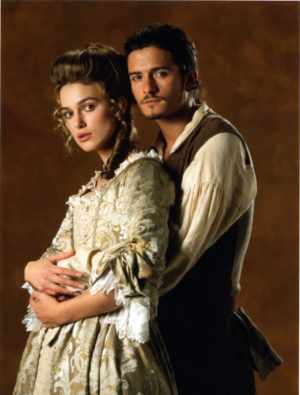
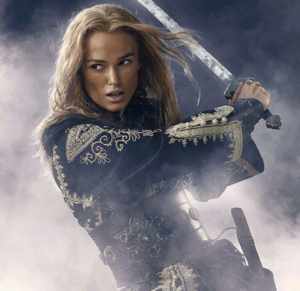
Much like the Bechdel Test, there are a few criteria a Strong Female Lead must meet in order to avoid the Swann Effect. Independent of Pirates’s marketing tactics, the Swann Effect is a product of the type of conflict a Strong Female Lead faces, how she resolves the conflict, and how much depth and authenticity is given to her character. The criteria is, due to nature of storytelling, too subjective to assign specific patterns to. Therefore, a case-by-case analysis is necessary in demonstrating the range and evolution of the Strong Female Lead that, occasionally, suffers from the Swann Effect.
Consider Princess Leia of the original Star Wars trilogy (1977-1983), who is a great example of a female character whose skill and wit are unscathed by the Swann Effect. Though she participates in a romantic subplot, she acts in accordance with her own desires (the key word is participates, not depends on). Additionally, the script reflects her importance as well her depth. We can follow her in a scene without the script demanding a male character’s presence; she is in a position of political power; we learn her origins and see her character adapt to new environments. Han Solo doesn’t get the same treatment by the script. Perhaps characters like Leia are the inspiration for the Strong Female Lead who demonstrates risk-taking bravery.
Beatrix Kiddo of Quentin Tarantino’s Kill Bill series (2003-2004) is in a similar position as Leia. She is untouched by the Swann Effect, and in fact, fighting against it. At the beginning of Vol. 1, she is punished for wanting her own story—a family and normal life separate from her murderous past. Additionally, she is not sexualized and shows emotion at appropriate times, like waking up from a coma and discovering the loss of her child, or recoiling from pain.
Women like Clarice Sterling in Silence of the Lambs (1991) or Ripley in Alien are early examples of the more stoic-type of Strong Female Lead whose stories depended on their personal actions, not those of someone else’s. Silence of the Lambs not only draws attention to the condescension endured by women in law enforcement, but highlights the serious face that Clarice must put on at all times, especially when men are harassing her. The social dynamics between the crew members in Alien are, for the most part, devoid of gender stereotypes or sexuality. The film presents two female crew members who are focused and capable without drawing any attention to the fact that they are women. Ripley is a commanding authority in many scenes, and is often the one who remains calm in life-threatening situations.
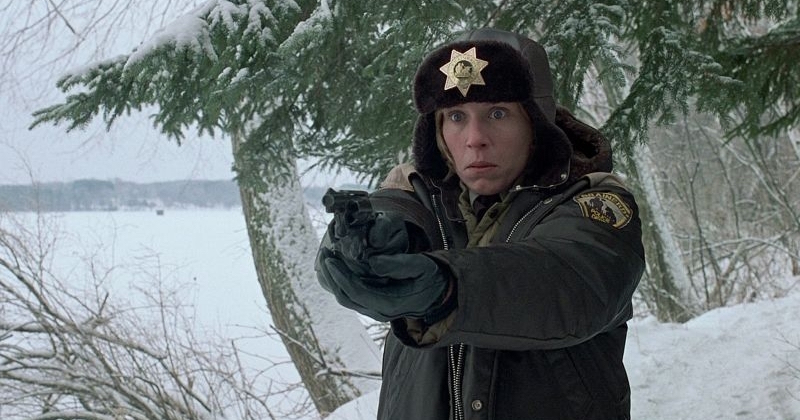
The charming and hilarious Marge in Fargo (1996) is a unique and overlooked Strong Female Lead who is also a stranger to the Swann Effect. As a pregnant police chief, Margie investigates a murder case which ends with her arresting one of the perpetrators, his partner already killed. Margie powers through morning sickness, conducts frustrating interviews, and has perfect aim with a gun from a distance. In physicality and personality, she is the opposite of the modern Strong Female Lead, which makes her a valuable anomaly when assessing depictions of female strength in cinema.
Hermione Granger of the Harry Potter film series (2001-2011) is another character who is not often associated with Strong Female Leads because her strength comes from intelligence as opposed to physique. Hermione of the film adaptations is treated differently than the one of the books, being summoned at convenient moments to serve as a prop to Harry (though Ron is given similar treatment). Overall, her character lies somewhere in the middle of the spectrum between a strong female lead afflicted with the Swann Effect and one who isn’t. Harry of the movies is a fairly complex character, but his conflict absorbs the other characters’ depth in the limited runtime. Hermione, though the more competent and hardworking of the three young wizards, has a rich background of interpersonal conflict that the films hardly tap into in order to keep the spotlight on Harry. In addition to conducting research on the group’s pressing issues, Hermione must learn how to assimilate into the wizarding world as a part muggle, part witch. Instead, the film gives the audience a peek at her inner struggles, meanwhile serving as a stepping stone to Harry’s resolution.
Enough (2001) starring Jennifer Lopez is inevitably a representation of the Swann Effect. Yet the film is valuable in marking the transformation of the Strong Female Lead on a symbolic level. It’s a story playing on the trope of a woman scorned by an abusive husband, though she transforms from the infantilized housewife into a highly-trained kickboxer to protect herself. Placing the conflicting reviews on the portrayal of domestic violence in this film aside, she takes control of her own narrative in a time where strong female leads were not only sparse, but an embodiment of sexuality. The film was a step towards the Strong Female Lead of the 2010’s, though ironically a step back from the Strong Female Leads of the 70’s or 90’s in which conflicts did not revolve around men.
In more recent years, Black Widow in The Avengers series has been Marvel’s wobbly crutch for female representation. Her addition to the all-male league of superheroes, Black Widow’s role is reduced to an object of male gaze, a romantic subplot, and the only one who fights by choking men with her crotch. She is an interesting character at the base who carries many attributes of Strong Female Leads like Furiosa and Rey. Unfortunately, she is a perfect example of the Swann Effect in action.
And finally: Katniss Everdeen. Previously mentioned as a female lead who has stereotypical feminine qualities, her character is subjected to the Swann Effect from the moment we see her with a male character. It should be noted that it is not automatically detrimental to a female character to have a love interest, be in constant relationships, have drama surround her romantic choices, etc. It is the way that these issues are approached in the script, as a central tension that unnaturally overshadows the more pressing issue of a tyrannical and murderous government.
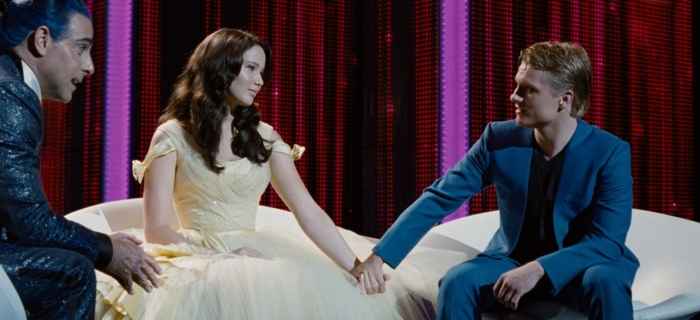
Strength in representation: empowerment and empathy
The use of women as props in storytelling, or the more humanizing term ‘catalysts for action,’ is not unique to women, as many men fall into these kind of supporting roles. Almost every story needs supporting characters to help the protagonist carry the plot forward. The rise in Strong Female Leads is, perhaps, a response to the default role that women have been assigned in the grand majority of blockbuster films. When Mad Max: Fury Road star Tom Hardy was asked if the film seemed “off-kilter” because several female characters were “propping up” what this reporter envisioned as “a man’s movie” (Cinemablend), his adamant “no” is the ongoing chant pushing for diverse cinema. In considering the importance of representation, Junot Diaz said it best: “If you want to make a human being into a monster, deny them, at the cultural level, any reflection of themselves.”
While equal representation is inching closer to being the norm, its importance is still underestimated in mainstream culture, especially in regards to ethnically diverse protagonists. The impact of seeing relatable, similar-looking characters on screen can not only extend one’s perception of their own abilities, it can also do the same for those who are really different. Telling stories that reflect an audience in all its proportions are both inspirational and educational. Roger Ebert said, “movies are like a machine that generates empathy. It lets you understand a little bit more about different hopes, aspirations, dreams and fears” (Finke). Viewers aren’t given the option to ignore a film’s protagonist, and therefore, plunge into the mind and motivations of another being. Due to film’s participatory nature, converting audiences into stone-cold witnesses, people must choose to empathize with the struggles others face. Research on the effectiveness of using literature to reduce prejudice provides quantitative evidence that we are transformed by the stories we consume, mostly via a larger capacity to understand others and seek out quality communication (Vezzali, et al.). There is obvious value in the Strong Female Lead, as society’s progression demands that we see see half the world’s population as more capable than we have in times past. And beyond demonstrating women’s strength, society is learning to recognize women as worthy subjects of complex stories, ones who are more than props for the stories of men.
Works Cited
Foreman, Amanda. “The Amazon Women: Is There Any Truth Behind the Myth?” Smithsonian Institution, 1 Apr. 2014.
Kirchoff, Courtney. “Dear Feminist Hollywood: Stop Trying to Make Female Action Heroes a Thing…” Louder With Crowder, 7 May 2016.
Kraljevich, Morgan. “The Myth of the Strong Female Lead.” The Sociological Cinema, 5 July 2015.
Lowry, Rich. “Can’t Wonder Woman Just Be Wonder Woman?” National Review, 6 June 2017.
Mulvey, Laura. “Visual pleasure and narrative cinema.” Screen,16.3, 6-18.
Vezzali, Loris, Sofia Stathi, Dino Giovannini, Dora Capozza, and Elena Trifiletti. “The Greatest Magic of Harry Potter: Reducing Prejudice.” Journal of Applied Social Psychology, 23 July 2014.
Wakeman, Gregory. “Tom Hardy Shoots Down A Reporter’s Notion That Mad Max Is A Man’s Movie.” Cinemablend, 28 May 2015.
“Watching Movies May Help You Build Empathy.” Public Radio International. 21 October 2015.
What do you think? Leave a comment.











I’m amazed people still go on about disparity between male and female lead roles when you can see there’s a strong movement a foot to change that. I went to see Julieta, Rogue One, Arrival, Elle, 20th Century Women and The Eagle Huntress over a couple of weeks and then realized… hey every single one of these has a female protagonist and two of them are big budget movies ( Arrival and Rogue One) . Change-is-a-coming….
You bring up a point that I may have not clarified well in my article. The point was not to focus on the disparity between strong male and female leads, but the character traits and type of conflicts that they experience. I’m glad that you don’t see a big disparity because that means we are making progress in some way. But the real concern is the type of representation that women have, not just representation itself (as we’ve already established). Thank you for reading!
Having a female lead in a blockbuster like StarWars is good for the studios, because that way they can better reach female moviegoers, alongside the traditional male audience. The guys won’t mind that, if there’s also some cool male characters in the movie (Except maybe in cases where the female protagonist is replacing some beloved existing characters as in Ghostbusters).
I think the lack of female directors of blockbuster movies could be because the studios are afraid that women might not direct action as well and might be reluctant to include enough action and the violence that often is required to make the action impactful. Sure, there’s always good old Kathryn Bigelow who can be mentioned as a counterexample, but she seems to be one of a kind.
I don’t think there’s any intentional discrimination going on, the studios are just trying to make movies that appeal to as many people as possible to maximise their revenues. Let’s say a female director for example wanted to make a Star Wars film with almost no action, with lots of cute creature shenanigans and basically make it a romcom, they would immediately lose most of their core male audience.
Although that also follows the assumption that men and women inherently gravitate towards disparate content. By the way, I’m not saying those gender-specific inclinations aren’t true to some extent. However, it would be a mistake to assume all women would want to turn action/adventure films such as the space opera Star Wars into romantic comedies. If that’s what studios assume in order to preserve their core male audience, then their decisions are built on a misreading of their potential audience. I do agree that there are instances where studios unintentionally discriminate, not necessarily because of any personal bias but because they simply want to make a lot of money and rely on the tried-and-true methods of getting it without trying to rock the boat by taking what they envision are risky ventures.
Here’s to women directors get more opportunities.
Female directors will show us the other perspectives of motion picutures. I am looking forwards to some masterpieces made by women.
Altho’ I’m a male, I gravitate towards female-protagonist movies because they generally require more original and intelligent screenplays. Female action characters are almost always interchangeable with male ones – and the truly memorable female roles aren’t going to be found in action films.
That said – Sigourney Weaver did some great work in the original Alien, which some might call an action film.
And Linda Hamilton.
Progress yes😀Still so far to go…also yes. Look at the names: Supergorl, Black Widow and Scarlet Witch. There is something missing in the very names. Girl not woman, widow lacking a husband and witch has a negative connotation.
We need better names!
Don’t you think you’re stretching the last two? Black Widow is named after a spider that mates and kills, and Scarlet Witch uses special powers. Lots of stories have been writing strong witch characters (Harry Potter, Discworld, Wicked) so it doesn’t have a negative connotation like it used to. Besides, Marvel already brought sorcerers into the mix.
I just want better names! Like Wonder Woman.
There’s an interesting dynamic that is going on in modern Hollywood films. The only way a woman can be seen as strong is by behaving in a traditionally masculine way: aggressive; violent; never succumbing to emotion (ironically, these same tendencies get labeled as toxic when men do them). We see femininity as synonymous with weakness.
Take Sansa Stark. She was constantly labeled as nothing more than a victim, but I would argue that she is one of the strongest characters (female or otherwise) on the show; yet Arya, who is the more masculine was the one depicted as strong. Sansa got her revenge on Ramsey and she never lifted a sword to do it.
One of my favourite movies of all time is Crouching Tiger, Hidden Dragon. Michelle Yeoh’s character Yu Shu Lien can fight like the best of them, but her character is still very traditionally feminine.
While I reject the notion that women should be exclusively feminine, they should also be more than the Mary Sue action heroes that are painfully good at everything (as a lifelong Star Wars fan I hate to admit Rey is one of them. Leia had faults, which is why she is so much more endearing).
Diversity should be about difference. Female characters should be treated no differently to male. They can be smart or stupid; they can be strong or weak; they can be powerful or powerless; just like the myriad of different people all around the world.
Women have always ruled, only behind the scenes. Now at front of stage.
It’ll be interesting to see how Hollywood adapts to the Trump era in the coming years — will studios pander to Trumpism and reassert male dominance in casts, or will they go the other way and make even more female-led films?
If female led films are successful at the box office, there will be more, if there aren’t there’ll be mess….it is a business after all. With the disaster that was Ghostbusters I can see why some studios may be very wary.
This article’s terrific! It’s so well-written and takes an important look at the changing narrative for women’s roles in the film industry. It saddens me how feminism (which at its core is simply about women being respected as human beings and individuals in their own right) is often disregarded nowadays as being either outdated or altogether unimportant. Female characters deserve to have complexities and depths to their narratives as those commonly found in male-led stories. Why wouldn’t that be worth exploring? I hope we as viewers will get to see more diverse types of female characters onscreen, whose defining characteristics won’t be the fact that they’re women. Great work, daniellegreen624!
Women will bring balance to the world when they have one-half the power in decision making. I hope it is in my lifetime. I hope it is NOW!
For me a strong female is just…well strong. There isn’t a specific definition. I like people who just get the job done and know they got something to do and do it.
Power female character:
– may exhibit human traits both positive and negative
– may appear vulnerable even weak, or flawed but the narrative sees her realize, confront and even overcome these flaws
– is not dependent on male characters to achieve goals
– has strengths that are mainly intellectual, creative or physical competencies not beauty
– probably, but not necessarily, written by a woman
– has never appeared in a Michael Bay film
why shouldn’t she have beauty as well as the other attributes ? Why shouldn’t a male character either, for that matter?
I hate Hollywood shallowness as much as the next man, but beauty hasn’t somehow been morally inferior to all the other characteristics just because of it.
Excellent point.
Haley Stark is the best example of a powerful female, physical smaller and weaker than the male she is up against. Haley manages to destroy the psychopath.” Hard Candy” is a brilliant essay on the mind of a psychopath.
Funny that you mention “Hard Candy”. I agree with you, not so much my husband. He absolutely hated the film, I’m sure you understand why.
I think the emphasis should be on “well-written” female characters.
A strong female character is one who’s in control and not afraid to express her opinion.
Fargo; Superb female leads.
Great observations that introduces the reader to important gender focused theories of film. This article comments well on a variety of different female characters and acknowledges the complexity of examining their true roles. The discussion especially of Elizabeth Swann is insightful and relevant and an interesting examination of the attempt at marketing female role models that is often undermined by the narrative they are then engaged in.
hollywood should look at something like This is England. believable male and female characters who are interesting to watch, focusing on both genders rather than on only one with the other in the background supporting. problem with hollywood is that it is all about target audiences, so there will be women’s films, men’s films, YA films, films for black people, films for this, that and the other. just make good films and, as the film says, ‘they will come’
Yes! That’s something I love about TIE, all the characters are so real, no one is a caricature of who they’re meant to represent
Ellen Ripley in Alien was brilliant and entirely convincing because there was no shoehorning of the ‘kickass’ strong female character for pop-feminist sensibilities.
Trying to force Hollywood into a quota for ‘strong female leads’ only serves to highlight and cause deeper divisions between genders. Ironically one of the most iconic ‘strong female leads’, Ellen Ripley, was originally written as a gender neutral character who could be played by man or woman. This gets down to the crux of things, let’s think about characters as people rather than vehicles for representation, that way I’m sure we’ll forgo the inevitable impending phase of token-female-playing-typically-male-character films which I’m sure everyone will complain about as well.
A strong female character is one that survives the opening credits.
Wonder Women is the ultimate: she can deflect bullets with her wrists.
Nowadays a ‘strong female character’ has to be openly – or suggestively – gay, or at least ‘bi’. ‘Black’ helps. At the very least her male ‘partner’ must be weak, ineffectual or, better still, gone – leaving her with the kid(s). Unless at least one of these boxes are ticked, we’ll call you.
Regardless of how any writer wishes to assert a strong female character in a film, they should do so with genuine motivations related to the story. There’s a great deal of justified cynicism about Hollywood cinema as there seems to be sociopolitical agendas inherent to certain projects.
Mad Max: Fury Road is a case where there’s a perfect symmetry in the assertion of strong females. The recent Ghostbusters film, however, struck me more as virtuous posturing. Although Wonder Woman as a film worked on the theme of a strong female character, the film itself was merely decent opposed to a masterpiece. It seemed that Hollywood and many writers sought to play up the positive reception while using the high box office to pat themselves on the back for being progressive.
You touched on the conversation about ethnically-diverse characters a little bit but I think it’s so important. Speaking as a white woman, films do not always properly represent me. However, I can only imagine how my women of color sisters feel. If they aren’t shown in a stereotypical light, they aren’t usually shown at all. I remember last year Naomie Harris spoke at a roundtable and mentioned how skeptical she was taking her role in the film, Moonlight. She did not want to play a negative stereotype. While the film and that character were incredibly beautiful and strong, I wonder about the other auditions and roles she had to choose from. It saddens me thinking about the way women like me and not like me are represented in mainstream cinema. However, that’s why it’s important to support women directors, writer, producers and all the others who work behind the scenes.
Really interesting piece! What do you think about the role of female director’s and producer’s agency (if they have enough agency….) in the production context of these kind of films with perceived strong female characters? Izzy
Definitely a rise in female powerful leads, look at Eleven in Stranger Things which has a generally young cast! It is a must for more female directors, as people say.
I like your discussion on the Swann Effect. There are plenty of quality movies with female leads, Park Chan-wook’s Lady Vengeance and the Handmaiden being good examples.
On the other hand the feminist agenda in an increasing number of recent Hollywood movies strikes me as particularly obvious (e.g. Ghostbusters).
Two different approaches here in my opinion.
This is such a fantastic piece! Your exploration is intriguing and I’m surprised I had never heard of the Swann effect.
I think Marvel’s Jessica Jones could be another example of a complex Strong Female Lead. From the title it’s already clear she is the main character and not a lazy asset. She has superhuman strength but struggles psychologically with trauma – including sexual trauma. Jessica’s experience as a survivor of sexual abuse adds an important, humanising element to her “strength”. Her relationship with sex isn’t represented only in her costume, unlike with many other female superheroes. It’s interesting to think about Jessica Jones in comparison to Marvel’s previous weak attempts with Black Widow, and what this means for social progression!
It’s wonderful to see powerful characters portrayed by women. I believe films like Mad Max are beginning to reflect how modern society is challenging the conservative construals of gender and sexuality.
I usually don’t have a problem with the Strong Female Character trope, but I do think there needs to be more range. We can have Black Widow and Charlie Theron in Atomic Blonde, but we also need female characters who are on all ranges of the spectrum. We need female characters who are strong, who make mistakes, who are gentle, etc. We can’t just have one type of Strong Female Characters. We need to show all the kind of strength women are capable of.
Loved this article! I really appreciated the explanation of The Swann Effect. I hadn’t heard of it before. I’m really looking forward to more strong female leads that are like Furiosa and Clarice. I wish there were more, but I understand progress takes time. I liked the break down between all of the characters mentioned in the article. I hope more diverse writers are welcomed in the writing rooms and more diverse perspectives can be represented. As well as characteristics. It frustrates me when certain characteristics are heavily gendered. But we, as a society, are working on it slowly.
Thanks for writing this!
I think the core issue is that someone coined the phrase “strong female lead”. It doesn’t mean physical (or emotional!) strength; it’s talking about the strength of the *writing*. When a work is praised for having strong female characters it’s really saying that they’ve written characters that are three-dimensional, fleshed-out, realistic, relatable, and any other trait or characteristic that male characters have been allowed to exhibit forever.
It’s toying with the novel and controversial idea that women are also people and we should write their characters as if they are.
As someone talked about above there exists a great example in Game of Thrones in the sisters Sansa and Arya Stark. (Book spoilers below). They’re both strong characters in the sense that they’re multi-dimensional, they have feelings and motivations and agency. Yet they are very different from each other. One is very physical, tom-boyish, disdains her culture’s idea of what a woman should be. One is not physical at all, lady-like, tries very hard to emulate her culture’s idea of what a woman should be (almost like she’s an adolescent trying to figure out who to be). Their actions have great effects on many events in the world. People literally live or die based on what Sansa and Arya do (or don’t do) but they accomplish these things by playing to their own strengths (one feminine, one masculine).
That’s what strong female leads are really about. Elizabeth Swann is not a strong female lead because she’s one-dimensional and has no agency, even if she masquerades as one because she’s allowed to put on pants and wave a sword around.
Great article – The Swann Effect is a v interesting concept